Stewardship, not ownership
First, I don't believe that we
'own' our land in the same way that we own a camera or a computer.
We are stewards of the land. It has been said that we don't inherit the
land from our parents, we borrow it from our children.
Any landowner who has allowed
his soil to be damaged substantially, or worse, to be washed or
blown away, has failed in his primary responsibility. Any
landowner who has left the soil in better condition than it was in
when he took on the stewardship responsibility can be proud.
It's a lot easier to work with nature than against it
I've learned that, with 46ha to try to manage, and with minimal machinery,
it is important to work out what 'fits' with the land and climate, rather
than trying to grow what is not well suited to the land. One tries to
- in a way - impose one's will on the top 20cm of soil; to stop it from
growing plants that one doesn't want (weeds) and get it to grow plants that one
can be satisfied with. The top 20cm of soil on 'my' property, I calculate,
weighs about 160 million killograms. I weigh about 75kg.
If I am to have any chance of 'controlling' two
million times my own weight of soil, with little use of machinery, I must do
things that the soil is well suited to doing.
As has often been said, you have to work with nature, not against it.
What I've called resources for this use are those things that are
available to me, are useful toward growing our trees and that I
have some significant influence over.
Soil
Soil is what any farm is all about.
At Elysium the topsoil is a thin silty loam, phosphate
deficient and with
very little structure. Beneath the topsoil is either stone or
clay. Drainage is very poor, when one walks in the winter water
'squelches' out from beneath one's rubber boots.
(See
water-logging.)
The best feature
of the soil is that it is loaded with worms whenever it is damp.
The soil, its structure and its drainage can be improved by
mounding
and especially mulching.
The soil can deeply crack as it dries in summer, with the risk of
tunnel erosion. On the other hand, I think that this cracking can
provide easy paths for plants to get their roots down to considerable depths.
Soil acidity, pH
Most of my soil is fairly acid.
In selected areas I am trying to gradually correct
this by the addition of lime and shellgrit. (The lime is quick
acting, but may be a bit hard on worms; the shellgrit is very slow,
but probably easier on worms.)
I also return the wood ash from my stoves to the soil (wood ash is largely
calcium oxide [quicklime] with significant amounts of phosphates and
potasium compounds); as with so many things, a little wood ash can be
good for a soil, more is not necessarily better.
Climate
Mediterranean; cool wet winters (frosts are fairly common, snow very
rare), hot dry summers. There is usually enough run-off in the
winter to fill an earth dam. Average annual rainfall is 600mm.
Water
The property has four small dams, only one of which is equipped with
a pump. There are three wells: one shallow old brick lined hand dug well
that is often dry, one unequipped drilled well with a small yield of
relatively saline water, and
one drilled well with a good yield of fair quality (1000-1100mg/L) water.
This last is the property's main water supply. Water from the dams is
less saline (200-400mg/L) than the well water.
Also see
irrigation.
I've included in this section things that I do to help the trees
survive, to conserve the soil, etc.
Irrigation
My irrigation of trees is by dripper. I only irrigate around the home
garden, all other trees make do with natural rainfall.
I try to water most of my fruit and nut trees from the dam; the
olive trees made do with well water when they were young,
they have had no water in recent years.
The salinity of the dam water varies between about 200-400 mg/L.
Many fruit and nut trees get watered about every couple of weeks in summer.
I'm sure many trees would do better if they received more water.
Some trees, including
oaks I've given some water during their first
summer, and then they have to look after themselves. Generally the only
water native trees get is a good soaking when they are planted.
Our olive trees were given some water for only their first four years or so.
Also see the entry on
water under
Trees: Resources.
Mounding
Planting a tree on a mound improves the drainage; the steeper slopes that
the mound creates helps excess water drain away. I have
been using substantial mounds since about 1999; my impression
is that they can, if large enough, solve the
water-logging problem. Water logging is
worse some winters than others; it was particularly bad in the relatively
wet winter of 2001.
Mulching
Organic mulching is very important in reducing evaporation and
improving the structure, drainage, fertility and water-holding capacity of
the soil.
I do not bring gravel onto the property for use as mulch, but I have used
slabs of rock to build retaining walls (see
Cellar) and as a border to paths (see
Stones for
water conservation).
In 2001 and 2002 I used grape mark as mulch (what is left after the
wineries have finished with the grapes: skins, stems, etc.) because
it could be had in the Clare Valley for the price of carting (in
18 tonne loads). In large quantities it is not suitable for use in
towns because it is strong smelling for the first few months.
I have found it to be quite acceptable: it is easy to handle, has no
viable seeds in it, reduces evaporation from the soil and
adds organic matter to the soil as it breaks down.
Unfortunately grape mark was not available from 2003 onward, so I changed
to sawdust (which was available from Morgan's sawmill at Jamestown
for about $200 for 30m3 delivered). This seems to be very
good; it is easy to shovel, light weight to cart, conserves soil
moisture very effectively, and controls weed germination.
Sawdust is water-repellent when dry and is slow to break down; this
latter means that sawdust does not seem to cause nitrogen-drawdown.
I have not been able to get sawdust from 2005 onward (when I 'phone
Morgan's they say that they will organise it, but it has not actually
happened).
Recently I have had a couple of
loads of tree-lopping mulch from Fox's. It seems to be quite acceptable,
but is not so easy to handle as sawdust; nitrogen-drawdown is heavy for
the first few months.
Cereal straw, or better yet, legume straw is also good for
mulching. Cereal straw can be difficult to get out of big round bales.
| |

|
When (and if) it rains the rain will run off the stony path and be
of some use to the pumpkins.
The bare soil in this area gets very sticky when wet.
The gravel will stop it sticking to boots.
All the stones used here came from the hole dug for the
cellar.
|
|
Water is precious and often in short supply at Elysium;
it is important to make the most of the limited rainfall.
Readers might have noticed that in the drier parts of Australia vegetation
is often more luxuriant adjacent to roads.
This is due to the fact that this vegetation effectively gets more rain
than vegetation elsewhere.
Roads, especially but not only sealed roads, do not absorb much rain water;
it usually runs off.
This is effectively a form of accidental irrigation.
A similar effect can be achieved by using stones to line paths (and gravel
as a base to a path).
The rain runs off the stone and soaks into the nearby soil.
Also, when the rain is over, the stone provides a barrier between the damp
soil and the air; reducing evaporation losses.
When using stones is this way one should consider that weeds will grow
between the stones (control by hand weeding and spot spraying), and that the
stones are heavy and hard work is involved in placing and moving them.
|
|
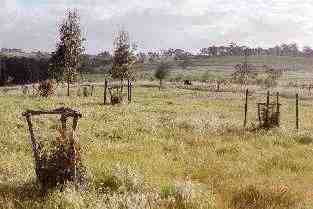
| |
The 'standard' guard is not always enough.
Sheep are particularly destructive anywhere near the top of a hill,
where these trees are. The small trees inside the guards are slow
growing carobs,
the bigger trees, Eucalypts and a sheoak, are
about the same age. It turned out that the soil in this area is
about as thin and poor as any part of Elysium.
|
|
If you are going to grow trees in the same area as you run sheep, tree
guards are essential for most species.
Some trees are more palatable than others:
- Very palatable
- Native pine, Casuarina, olive, apricot
- Moderately palatable
- Eucalypts, Callistemon
- Fairly unpalatable
- Acacia, English oak(?)
- Quite unpalatable
- Bunya pine
I have not planted most of my fruit and nut trees in places where the
sheep can get at them, so do not know how palatable they are.
My standard tree guard is 1.05m wire netting wrapped around an old
car tire as a base, and with a rough frame of either pine or gum
sticks, wired to the tire and wired together at their ends, to
protect the guard from crushing by
sheep.
This protects against hares as well as the sheep.
Once the trees start to stick out the top of the guard, the sheep
will reach over and eat them; one of several things can be done:
- Replace the 1.05m netting guard with a 1.20m one;
- Replace the netting guard with a 1.2m
welded mesh guard;
- Add a netting extension to the top of the guard.
- Hope that the tree will outgrow the sheep during the period when
the sheep are absent;
The disadvantage of the welded mesh guards is that they cost about
$15 each compared to $5 for the netting ones. They can of course be
moved on to other trees as required.
Here I've listed those things that work against my aims, the hurdles
I've had to try to overcome, and what I've done about them.
Tunnel erosion
There are several drains running around the sides of the Elysium
hills to collect water and deliver it to the dams.
In the summer, as the subsoil dries and the clay shrinks,
deep cracks can appear in the soil and subsoil.
When sufficient rain later falls for runoff to occur, where the
cracks cut across the drains, water can flow beneath the bank bounding
the drain, washing some soil with it, beginning the process
of tunnel erosion.
I wish I had a simple cure to offer for this problem, all I can
suggest is:
- Watching out for leakage from drains as soon as the first runoff
for the year occurs;
- Closing up the cracks if they are small by, perhaps, driving a
tractor over them;
- If holes wash out, digging down and packing them with stones,
gravel, and soil;
There is one place where I've had to repeat the third step at least
six times; I seem to be getting on top of the problem, certainly
there has been very little erosion happening there in recent years.
Root competition
Established South Australian blue gums
Eucalyptus leucoxylon
will stunt the growth of, or even kill, many other trees planted
within a 50m radius.
Water-logging
The soil on Elysium has very poor drainage and the consequent
water-logging in
winter (especially in the more than usually wet winters), it seems
to me, weakens the root systems of the trees. I suspect that the
saturated soil in winter also discourages root development, while in
summer the soil is probably too hard for roots to grow through it.
This can be at least partly
controlled by
mounding and
mulching.
Recycling waste water and soil sodicity
Our waste water goes into the garden soil.
This can result in the soil becoming
sodic with consequent
loss of fertility.
We try to minimise this risk by minimising our use of sodium-containing
bathroom and laundry products, minimising our dietary salt, and adding
wood ash and lime to the soil.
Pests
Sheep
I need sheep to eat some of the 'grass' and so reduce the summer
fire hazard. Sheep do produce some income from agistment payments, but
I have paid far more for fencing and tree guards than I have received from
agistment.
However, sheep are very destructive; they will eat the leaves of
most trees, possibly destroy a
tree guard in the process, and they
will sometimes ringbark trees as well.
Sheep are particularly destructive anywhere near the top of a hill
where they like to camp. Unfortunately, tops of hills are good
places to plant trees: to reduce the wind speed a bit and even to
provide some shelter for the bloody sheep!
Lurps
Eucalypts can be setback by a heavy infestation of lurps (leaf
eating insects). In my experience no action is needed to control
them, as the trees will almost invariably fully recover in about a
year. I have had young trees almost entirely defoliated by what I have
taken as being lurps.
|
|

| |
I built this 81m2 bird exclusion area, based on 3m creosote poles
and wire netting, in 2004 at a cost of about $900.
|
|
Fruit eating birds
After nine years we had only picked one decent crop of ripe apples; no pears,
no nashis; the birds usually get them first. The crop of apples was on a tree
that we completely covered with wirenetting before the apples were ripe.
They are a little slower to get stone fruit, harder on peaches
and nectarines than apricots and plums; but still, we loose a lot.
I suspect the only way to protect your fruit is to completely net the trees.
We have tried a plastic hawk tethered to a pole; didn't seem to have
any effect at all. One trick we heard of recently was to spray the
ripening fruit with Omomatic (clothes washing detergent), the birds
supposedly will stop eating because they don't like the taste, while
it is easily washed off before human consumption. Might be worth a try.
The only answer that I can guarantee is netting, as in the illustration
at the right.
Kangaroos seem particularly partial to figs; I might have to set up a
temporary electric fence around two fig trees (2010/02/21).
Mistletoe
In my experience at Elysium, only a problem on
SA blue gums. It is very common throughout
the Clare Valley and can kill adult trees.
The mistletoes are natives, (family Loranthaceae) and were
at one time in some sort of a balance with their hosts, but the
clearing of much of the land seems to have upset that balance.
There is a mistletoe Action Group in Clare that, for a time helped pay for
lopping mistletoe from your trees. Contact the Council. (July 2002)
The cost of professional lopping of mistletoe from a large blue gum is
more than $100 per tree.
I've included in this section all
those trees that produce an edible product generally termed
'fruit';
nut trees,
oaks and
carobs are in their own section(s).
In alphabetical order of botanical names
|
|

| |
Photo May 2007 - This tree was planted about 1996
|
|
Feijoa: Acca sellowiana, pineapple guava
Native to southern Brazil and northern Argentina,
feijoa seem very well suited to Elysium. We planted our first about
1996 and it's still doing well; perhaps a little slow growing
compared to some trees, but always looks healthy. It has produced a good crop
of fruit each year after about its second.

| |
Some of the very heavy crop of 2007
|
|
|
The fruit are tasty, slightly astringent, (no pealing needed, no stone or
large seeds to spit out), and the birds haven't recognized that they are
edible.
We planted a second tree about 2000 and it produced its first crop
in 2003. Unfortunately the fruit from this
tree is not so nice as that from the first, although they
do improve when allowed to become very ripe.
This tree is apparently a different variety to the first.
Feijoas do better at Clare if they get an occasional deep watering through
the summer.
I have not mounded these trees, they don't seem to need it.
See also the true
Guava.
| |

| |
Planted about 2002, photographed 2009/11/26
|
|
Cherry: Prunus ?lusitanica
We have two of these, they have done well
in spite of the soil being particularly shallow and stoney in
this area.
They produced a very few cherries for the first time in the
summer of 2005.
In 2006 we had a 5L bucket of cherries from each tree, there was a good
crop again in 2007.
In 2008 the birds got the lot; the photo shows another fair crop in 2009.
| |
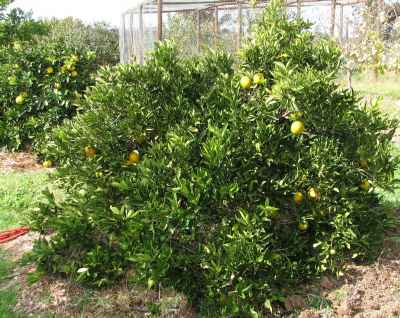
| |
May 2007 - The foliage is a healthy dark green, I've found
it very difficult to get such healthy foliage on citrus trees in
another area.
|
|
Citrus: Citrus s.
I have been surprised at how well our citrus trees have done.
We have orange, lemon, grapefruit, mandarin and lime.
The Citrus trees have been mounded, although I've seen no
evidence that they suffered from
water-logging. We were warned to not
plant Citrus until about September to reduce the risk from
frosts.
We did this, and have never seen any indication of frost
damage.

| |
January 2002. This tree has produced a couple of useful crops, and
it looks like there is another on the way. Ready to pick in March?
|
|
|
Quince: Cydonia oblonga
The quinces too have done very well; no indication of problems from
water-logging. I have
mounded the more
recently planted quinces, but the first, which was not mounded, is
still doing very well.
Quinces are attacked by
birds, but not to the
same extent as are stone fruit or
apples. Another advantage of
quinces is that since they are usually grown on their own roots they
can be propagated from suckers.
Quinces cannot be eaten fresh, but are good stewed and make a delicious
clear quince jelly that can be used like jam.
Persimmon: Diospyros s.
We planted three in one year, all died; I don't know why, but with
that result I wouldn't recommend trying to grow persimmons in the
Clare Valley.
|
|
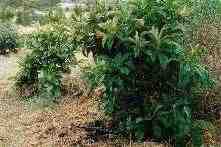
| |
January 2002 - These two loquats seem to handle the soil and climate
at Elysium with ease.
|
|
Loquat: Eriobotrya japonica
We planted two trees grown from suckers about 1996. They are close
to our septic tank outflow and are doing very well.
They have not been mounded.
We removed these trees in 2005 because, while they remained healthy,
they did not produce a useful crop.
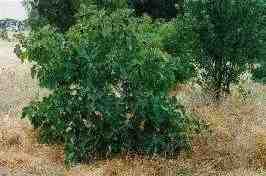
| |
This tree has produced several good crops in spite of not getting a lot of
water or other attention. January 2002.
|
|
|
Fig: Ficus carica
Figs seem well suited to conditions in the Clare Valley, although if they
are to bear a good crop they do need a fair bit of water, either natural
or by irrigation. We planted
our first trees about 1994, while one died very soon after planting,
the other original is still growing well and regularly producing fruit.
We have planted several more since.
They are easily propagated from
cuttings or suckers, but do not like their roots
disturbed when planting. In future I will pot any that have bare roots
so that I can give them close attention and plenty of water, and only
plant them out - with care to not disturb the roots - when established in
the pot.
Mounding does not seem to be necessary, the trees have shown no
signs of suffering ill-effects from water-logging.
Kangaroos seem particularly partial to ripe figs.
|
|
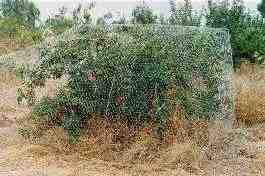
| |
The wire-netting is the type commonly used for
farm fencing. It protected the apples from birds; we picked a big crop
in February 2002.
|
|
Apple: Malus s.
Our first trees were planted about 1994. They have done fairly well,
although I'm sure they would do better with more water in summer.
We had never had any fruit from them up until 2002, the birds
always got it first.
Apple trees (and other pome fruit trees) do not seem to suffer so much
from either the summer droughts or winter water-logging as stone fruit trees.
It seems that fully covering apple trees with netting is the only
way to protect them from
birds, which will start on
apples and pears when they are still green and hard.
Apples and pears seem to do fairly well even without water in addition to
natural rainfall.
White Mulberry: Morus alba
Doing quite well, but not getting as much water as it needs. I strongly
suspect that building up the organic matter in the soil would greatly
help. We have had very little fruit from this one, probably because of
the neglect.
|
|

| |
This mulberry tree is growing well. Photo January 2002
|
|
Black Mulberry: Morus nigra
Doing quite well, but not getting as much water as it needs. I strongly
suspect that building up the organic matter in the soil would greatly
help. A good fruit producer given the insufficiency of water and
general neglect.
I have planted several more since these first two, but they are not yet
(April 2007) old enough to produce a crop.

|
Having a tea break during olive picking.
A fair part of Elysium is visible in the background.
|
|
|
Olive: Olea europaea
Olives grow wild in the Clare Valley, they are a woody weed in some
places! Consumption of pickled olives, and even more, olive oil, is
increasing steadily in Australia.
One would think that olive trees would have to be a commercially
viable option.
My impression is that they don't like the water-logging that happens
almost every winter, and that they need more water than I am prepared
to give them if they are to set a commercial crop in the spring.
They seem to suffer from the fairly quick change from wet feet to hard,
dry soil in spring; especially as this often coincides with their
flowering.
Still, if you only want some olives to pickle and some oil to use
yourself and to give away to friends, then, by all means, plant some
olive trees.
The SA Verdale variety seem to produce the largest crops while not
getting any irrigation. Manzanillo is another good cropper, but it
has a reputation for being difficult to extract the oil from the olive pulp.
|
|
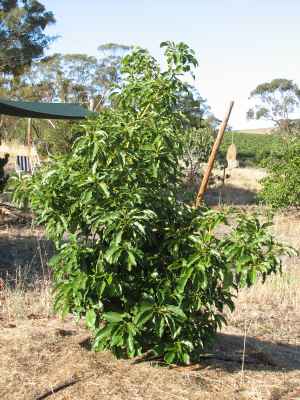
|
Avocado tree
Photo Jan. 2007
|
|
Avocado: Persea americana
We planted the first two avacado trees about 1996. They did well for a
year or so, then died.
I believe that the problem was to do with
water-logging in winter
and hard, dry soil in summer.
Mounding will help avoid
water-logging and mulching will conserve moisture and eventually improve
the soil.
We planted another avocado in 2005 and early in 2007 it has produced a
few fruit and is still doing well.
It has been kept heavily mulched, has been mounded, and watered fairly
regularly through summer.
I'd say that if you want to grow avocados in the Clare area, they will need
a place that does not get heavy frosts, low salinity water in summer,
and protection from water-logging in winter.
|
|
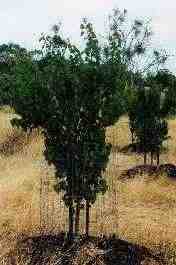 January 2002 - This Moorpark tree was planted in winter of 2000.
It and five others nearby are doing well. Note the weld-mesh
tree guards; these are the next stage
after trees outgrow the simple, cheap, wire-netting
guards. Also
note the
mounds and
mulching.
January 2002 - This Moorpark tree was planted in winter of 2000.
It and five others nearby are doing well. Note the weld-mesh
tree guards; these are the next stage
after trees outgrow the simple, cheap, wire-netting
guards. Also
note the
mounds and
mulching.
|
|
Apricot: Prunus armeniaca
We planted about five in 1994. They grew well and produced a couple of
good crops, then died. Again, I believe water-logging to be the problem.
We planted another six trees in the winter of 2000, this time on mounds.
They are producing good crops and, in early 2007, are still looking healthy.
Sheep find apricot leaves, and even bark, very
palatable.
|
|

| |
Two plum trees in January 2002
|
|
Plum: Prunus domestica
Plums grow wild in the Clare Valley, but the wild trees seem only to
produce a crop following a better than average year, and then the fruit
is very small.
We planted about ten trees in 1994. These produced quite a heavy crop
once in a while. Most of these have not been watered in recent years and
seem rarely to produce a significant crop.
A couple of satsumas that were planted where they can be conveniently
watered through summer are producing much larger and more reliable crops.
It seems that while plum trees grow like weeds in the Clare Valley, in order
to get a crop from the better breads, they will need additional water
through the growing season.
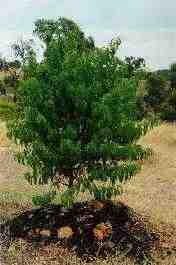
|
|
A peach tree at Elysium, in its second year of growth; January 2002
|
Peach, Nectarine: Prunus persica
These do well enough for a few years. We've had some die, probably
because of
water-logging or insufficient water through summer;
mounding seems to be essential.
They need protection from
birds, treatment for curly leaf in early spring and watering through
the growing season.
The tree in the photo on the right is still doing well in 2007.
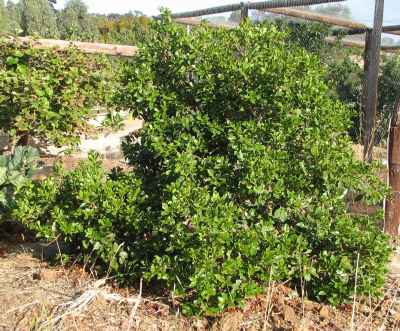
|
Strawberry guava
Photo Jan. 2007. It is about 1m high.
|
Strawberry Guava: Psidium cattleianum
Planted in 2001; as of May 2003 it has produced several small crops and
is growing slowly. In 2005 and 2006 it produced quite a good crop.
The fruit are small, extremely rich in vitamin C, and have a
strawberry-like flavour. They can be eaten fresh, or made into jams and
jellies.
Also see Feijoa,
which are alternatively known as pinapple guava.
Pear, Nashi: Pyrus s.
Our original trees are doing fairly well, would probably do better with more
water through summer. They were planted in 1994. Birds eating the
fruit is a big problem, as can be cherry slug.
Several were planted in a large bird-excluding enclosure in 2004.
By 2007 they had produced some fruit.
In this section are the 'edible' nuts, including Australian natives
such as
Macadamia and
Bunya pines.
The
English oak is
excluded, although I believe acorns can be eaten if one is
sufficiently hungry. The Acacias have been excluded, even though
their seeds are edible; indeed, quite tasty, although I can't see them
becoming more than a novelty item on any menu.
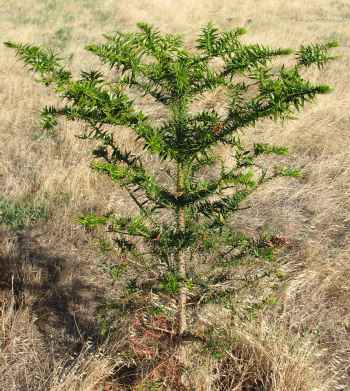
|
Bunya pine tree
Photo Jan. 2007
|
Bunya: Araucaria bidwillii
My son, Ken, gave me three small seedlings in early 2000 after I had
made several unsuccessful attempts to grow them from seeds.
In January 2007 two of these are still alive, looking healthy,
but they are growing very slowly.
In my experience, it's not uncommon for trees to sit and do nothing for
the first year after being planted out, but it looks like growth on
these bunyas will remain slow.
Bunyas, which are related to the famous and extremely rare walami pines,
can grow to very big trees in South Australia.
They are one of the very few trees that I have come across that
are entirely unpalatable to sheep.
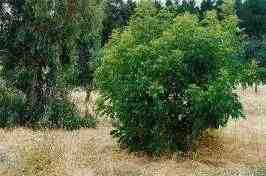
|
The very healthy looking pecan tree, with a red gum on the left.
Photo January 2002. In Jan. 2007 this tree is about 4m tall.
|
Pecan: Carya illinoinensis
We planted one pecan tree about 1994. It is growing very well; the picture of
health. It has only produced fair crops of small nuts
(as of 2007), probably because it gets no water other than natural.
I believe that pecans are not very self fertile. We planted several more
trees around 2004 and 2005 in locations where they can be watered; they
have not yet (2007) produced a crop.
The red gum in the background of the photo,
planted about the same time as the pecan, was removed in early 2003.
Chestnut: Castanea sativa

|
Chestnut
Photo Jan. 2007
|
We planted one around 1996, but it died. This may just have
been bad luck.
The second one, planted in the winter of 2002, did show some salt
burning in 2003, probably because it was irrigated
with bore water at around 1100mg/L through the summer.
In early 2007 this tree is doing very well and has produced some nuts.
Walnut: Juglans s.
We planted two in about 1997. Both died. I suggest they need lots of good
quality water, or exceptionally deep, rich soil, and perhaps good drainage,
if they are to do well in the Clare Valley.
One other, dug out in about February 2007, is still surviving in late
April 2007.
Macadamia: Macadamia tetraphylla
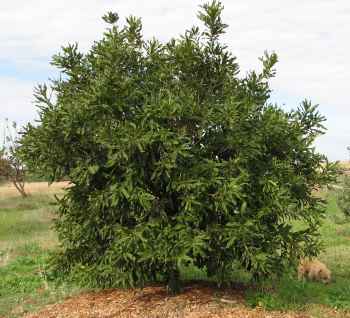
|
|
A macadamia tree, photographed May 2007
|
Two were planted about 1997 and three more two years later. One died (unknown
cause), all the others are doing so well that I wonder why
there are not many more in the Clare Valley.
I suggest
mounding to protect them from
water-logging and mulching to conserve water and improve the soil.
We planted three more in 2006. As of early 2007 the four surviving older
trees are still producing many nuts. My impression is that the trees need
a fair bit of water if they are to grow large nuts.

| 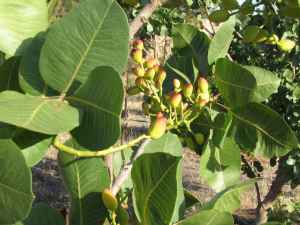
|
|
Two pistachios, January 2002 - the tree on the right should have
been pruned when dormant in winter.
| Ripening nuts on a pistachio
Photo Jan. 2007
|
We planted two about 1996, one of which died shortly after.
We planted another about 1998. Both trees are looking very good, but
unfortunately, both turned out to be male.
Male and female trees are needed to produce fruit.
We have since planted two females, one of which, although still (2007) very
small, is producing well. I'd suggest mounding pistachios.
As of May 2003 the pistacios were still doing well, but not yet producing.
In this section I've included only Australian native trees that do not produce
what are generally thought of as edible nuts. For example, I've
excluded the
Macadamia and the
Bunya nut, even though they are natives;
native trees that produce edible nuts are discussed under
Nut trees.
Several native tree species (mainly
Eucalypts, possibly also
Casuarinas)
are suitable for the production of
firewood in the Clare Valley. Firewood that can ethically and
legally be cut is becoming scarce in South Australia, forcing
prices up and making it more attractive as a crop. Also see my
section on
firewood
as an environmentaly sustainable heating fuel.
I suggest planting large wood-lot species no closer together than 8m,
or even as much as 20m if you want to graze between the trees.
If you plant at spacings as small as 3m, as I did initially, the trees
will be heavily competing with each other by the time they are four years
old. By the time they are ten years old the larger trees will only be
able to grow by killing the smaller trees.
Through years of trial and error at Elysium
I have come to the conclusion that the
best way of planting those native species that are easy to grow at
Clare is as follows (this technique has been developed for broad-acre
planting of many trees with minimum expense and effort but without
special machinery):
- The tree or shrub to be planted should have a healthy growth of roots and
must not be pot bound. If it is pot bound then you should pot it up
and allow its roots to spread into the new soil before you plant it out.
- Ideally plant anytime through the late spring, summer, or early
autumn while the soil is warm.
Trees planted when the soil is cold
(winter: June to August) will not do anything until the
weather warms, and while they are doing nothing they are vulnerable.
If planted while the soil is warm they will continue growing.
Also, working in mud in the cold of winter is not pleasant.
- Loosen an area of soil about 60cm in diameter to a depth of
about 20cm (the full length of the prong of a pick). The hole can
be more shallow toward the edge: bowl shaped.
- Break up the large clods of earth.
- Take the plant out of its tube or pot and break up any mat of
roots on the surface of the root mass, trying to leave the bulk of
the root mass as intact as possible.
- Plant with the top of the root mass a few centimetres lower
than the general ground surface.
- Fill in around the plant to the top of the root mass. The
aim here is to leave a shallow depression with slightly raised
walls; sufficient to contain 5 - 10 litres of water.
- Saturate the loosened soil. If you can't slowly pour on at least
20L without it running away you have not loosened enough soil.
Of course much less water will be required if the soil is already damp.
- Cover the loosened soil with mulch. For preference I use
about 20L of sawdust, but anything that will suppress weed growth
and reduce evaporation can be used, eg. newspaper,
the chopped leaves and sticks from roadside tree trimming, grape mark, etc.
It is important that the mulch covers all the soil that you have wet,
so that germinating seeds will die from lack of light.
- This treatment will probably give a local native tree enough water
to survive the remainder of the summer. If there
is a long period without rain, or a period of exceptional heat,
additional watering may be required. I find that it is easier to replace
the few trees that die than to do additional watering rounds.
- You can use an old car tyre both as a marker and to discourage the
occasional rabbit,
hare or kangaroo from browsing the seedling. More protection
will of course be needed if sheep are going to be grazing or for the more
palatable species (eg. Allocasuarinas and Callitris); see
Tree guards. Without a marker
you will loose track of where you have planted the trees. Don't forget to
remove the tyre before the tree becomes so big that you can't.
- Weed growth will be a greater threat to the newly planted
tree than hot or dry weather; weeds suck all the water from the soil very
efficiently, and they can crowd-out small trees.
I planted a number of gums at the end of January 2004 using the
above method. February was exceptionally hot; none died. I
think I gave them a couple of waterings after planting.
I planted again in the summers of 2005 and 2006. I did very
little summer watering, few trees died. Many more of the trees that I planted
in winter died than those planted in summer.
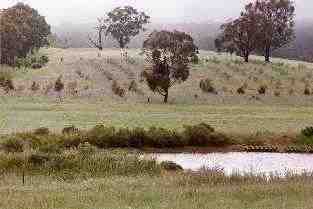
----- Photograph -----
Honey-myrtles
Melaleuca acuminata or brevifolia?
around the
wall of the dam (they have fine roots, not likely to make a hole
which could cause the dam wall to fail).
More distant is a plantation of mainly
Eucalypts, some
Allocasuarina. (I planted these trees too close together. My
current thinking [2007] is to plant big wood-lot species no closer together
than 10m.) This is the same patch of trees as shown on the first photo
at the top of this page.
Beyond the Eucalypts and Casuarinas the paler trees are
olives.
The big trees are
blue gums, probably
fifty or more years old.
The photo was taken about November 2000.
Wattles: Acacia species

|
|
This Acacia notabilis was grown from seed and planted, together
with many more, on a nature strip on Elysium adjacent to the
Blyth road.
|
These are wonderful trees if you like blossom and scent. The
different species flower at various times of the year, and their
fragrance is pleasant and quite strong. At best they cover themselves
with bright yellow blossoms.
While many have short lives, a decade or less, others can live many
years.
They are easy to grow from seeds, although once I had a
whole box of about fifty seedlings that failed to do well; just
sat and felt sorry for themselves.
More a shrub than a tree really, still I couldn't resist including
it. It flowers profusely around July or August, right in the middle of
winter when nothing much else is flowering; I often feel it's the first
sign of spring.
A large shrub or small tree that is unusual for an
Acacia in
having needle-like phylodes rather than flattened leaf-like phylodes.
Bright yellow blossum, although perhaps not as showy as
notabilis
or
pycnantha.
These trees have, as the name implies, a beautiful drooping habbit when
they reach maturity. I believe they are one of the most beautiful of the
wattles in their own right - the blossoms are not particularly striking.
Golden wattle: Acacia pycnantha
This small tree, endemic to the Valley, grows well and quickly, can
produce a beautiful crop of yellow, strongly scented blossoms, but
unfortunately has a short life: perhaps only five or six years.
Seedling come up uninvited, apparently being brought in by birds; all
they need to grow then is protection from the
sheep.

|
|
Planted about 1994, photographed 2002
|
Allocasuarina
The
Allocasuarinas and
Casuarinas self-seed more effectively
than most natives.
Sheoak: Allocasuarina verticillata
Very palatable to sheep, so requiring sound protection while within
their reach. Not only do the sheep eat the neadles, but will ring-
bark the young trees as well if given the opportunity.
This tree grows quite well at Elysium, although
certainly more slowly than the Eucalypts.
An alternative name is Casuarina stricta.
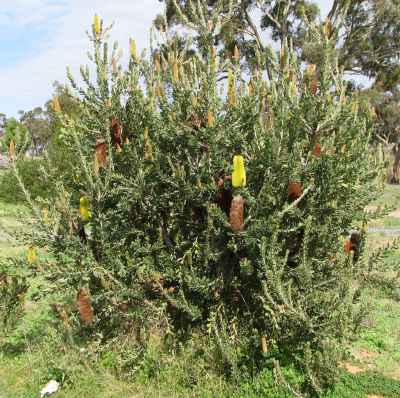
|
|
This tree was planted about 2002 and the photograph taken in May 2007.
|
Banksia s.
Our greatest disaster. It was my plan to grow Banksia flowers for
sale to florists as one way to produce a bit of income. Ken, my son,
and I bought some in tubes and raised others from seed. We planted 80 or
more, only to have every one of them die.
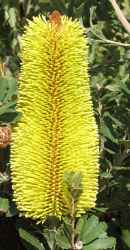
|
|
A blossom on the same tree
|
Yet Ian Roberts, at Banksia Park, which is within easy cycling
distance, grows them quite successfully. I can only ascribe my
problem to lack of good soil drainage; they couldn't stand the winter
water-logging.
In more recent times I have planted several Banksias in small
heaps of sand and most of these have done quite well.
Illawara Flame Tree:
Brachychiton acerifolius
----- Photograph -----
Illawara flame tree or flame kurrajong; January 2002.
This specimen was planted about 1996; as of June 2003 it has not
yet flowered.
Not fast growing, but neither are they at all difficult to grow;
Several of these have been sucessfull at Elysium.
They have not been given any special attention.
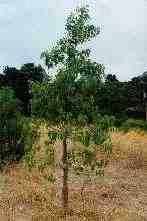
|
Callistemon
A number of trees grown from seed were planted; they are doing moderately
well. They seem to appreciate a fair bit of water in the summer,
especially if a good show of flowers is wanted.
Those grown from seed do not seem to hold their flowers for long compared
to the Gawler Hybrid.
Callitris
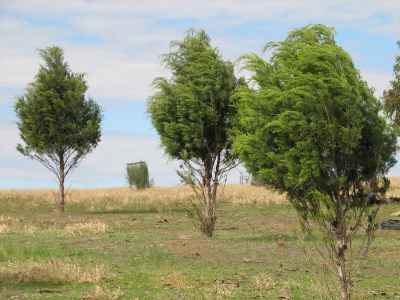
|
These trees were planted about 1999.
The lower part of these trees have been defoliated by sheep.
|
Native pines do very well at Armagh.
They are very hardy but very palatable to sheep. Care must be taken with young
Callitris that the sheep do not ring-bark them.
Callitris are also very slow growing, however they are beautiful trees and are worth waiting for. One of my favourites of the local natives.
These may be C. preisii or C. collumnaris.
Callitris are easy to grow from seed and will self-seed.
What do I need to say as an introduction to gum trees? In case the reader
has not read much about, or visited Australia, gum trees are the
essence of Australia. Australia would not be Australia if not for
gum trees.
There are over 700 species, most of them endemic to Australia.
Depending on their type of bark and their growth habit Eucalypt
species are often placed in groups such as box trees, mallees,
stringybarks and ironbarks.
Gum trees were, with the Australian landscape, the main subject
of the great Australian painter
Hans Heysen. Most often he painted
red gums.
The section on
Planting native trees
applies especially to Eucalypts.
A pest of Eucalypts is
lurps.
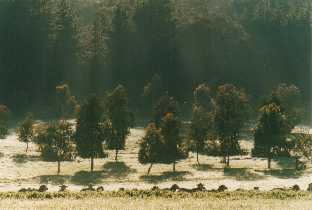
|
|
The young trees in the photo are red gums that were planted about
1994. This gully becomes very wet every winter; the red
gums are plainly thriving. Pinus radiata in the background.
|
A truly remarkable tree; very tolerant of water-logging, easy to
grow and quick growing, not bothered much by frosts, and drought
tolerant. The only place I've found where they don't do well at
Elysium is where they have some shade and root competition from
established
Pinus radiata and
blue gums.
Red gums are suitable for the production of
firewood in the Clare Valley.

|
Sugar gum: Eucalyptus cladocalyx
A little harder to grow at Elysium than
red gums and
Tasmanian blue gums,
but a very attractive tree when mature, and worth the little extra effort.
They grow very well once established.
Sugar gums are probably suitable for the production of
firewood in the Clare Valley.
----- Photograph -----
This tree was planted about 1994 and photographed in 2002. Note the very
dense foliage; this seems typical of most young, healthy gums at Elysium.
|


|
|
The tallest trees in this photo are Tasmanian blue gums.
|
Tasmanian blue gum:
Eucalyptus globulus
This, we have found, is the second easiest tree to grow (after red
gum) at Elysium. It is generally even faster growing than red gums,
and while juvenile
globulus have distinctive leaves, the
older trees with mature foliage look somewhat similar to red gums, but
are straighter, more inclined to go upward rather than outward, and
tend to have shaggy bark on the lower half of the trunk.
Tasmanian blue gums are suitable for the production of
firewood
in the Clare Valley and would have to be about the best tree for the
production of polls because of their tendency to not fork and go straight
up.
----- Photographs -----
|
The tree in the centre of this photo is a Tasmanian blue gum.
|
All these trees were planted about 1994 and photographed
in October 2007.
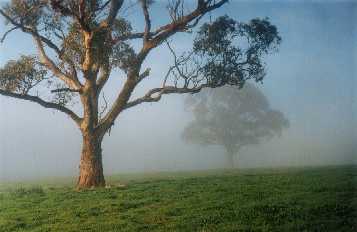
|
|
There were about fifty large SA blue gums on Elysium when we
bought the property. Here are two of them on a misty winter morning
in 2000.
|
South Australian blue gum:
Eucalyptus leucoxcylon
Blue gums are endemic to the Elysium area; they produce seedlings
that, with protection from sheep, will grow quite sucessfully.
One of their annoying habits is a tendency to grow any direction
other than upward; it makes them slow to get out of the reach of the
sheep.
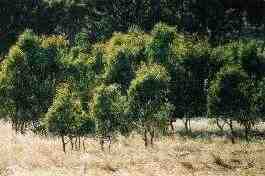
|
|
These blue gums are self-sown. All have grown from seeds dropped
by one large old tree. January 2002.
|
A pest of SA blue gums is the parasite
mistletoe. Older trees can become so heavily
infested that they may die.
For a time a government grant was available to pay a
part of the cost of removing heavy infestations (2002).
SA blue gums are suitable for the production of
firewood
in the Clare Valley.
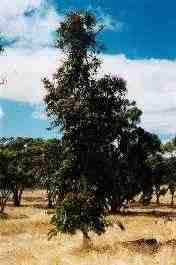
Spotted gum: Eucalyptus maculata
Certainly a difficult tree to grow compared to
red gums and
Tasmanian blue gums,
but an exceptionally attractive one when mature,
with a tall, straight trunk and near white smooth bark.
It may be the frosts that are hard on the young trees.
----- Photograph -----
This spotted gum was planted about 1994 and photographed in January 2002.
Grevillea

|
Silky oak: Grevillea robusta
We planted perhaps forty of these around 1995; I'd guess that 1/2
are still living. Some were killed by sheep who find the bark very
apatising, some died from some other
cause; perhaps they needed more watering in their first summer.
----- Photographs -----
This is one of only two survivors on our 'big hill'. The wire-netting
on the trunk protects the tree from being ring-barked by the sheep;
some of the damage inflicted before the netting was put on can be seen.
January 2002.

|
Paper barks, Tea-trees: Melaleuca
Fifty of these have been planted just above the high water mark of a
dam, possibly
brevifolia or
acuminata. They have done
well, but seem to be getting close to the end of their lives now, about
seven years later.
Black tea-tree, moonah:
Melaleuca lanceolata
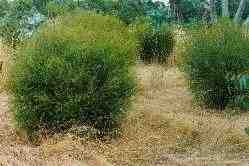
|
|
Three Melaleuca lanceolata on the nature strip beside the
Blyth road at Elysium; photographed January 2002.
These were planted about 1994.
|
A number were planted in a fenced strip adjacent to the Blyth
road; doing quite well.
They are an attractive tree. The blossoms are not spectacular.
I've included in this section all those trees that are not native and
don't produce anything generally termed either
an edible fruit or nut. It is not really such a simple definition.
Carob: Ceratonia siliqua
St John's Bread is another name for the carob; referring to the edible
seed pod. The carob is an attractive tree, and apparently the seed
pods fall in the summer when there is little other stock food
available. I've tried them; wouldn't like to eat them myself.
Young carobs might need to have their bark protected from sheep. I have had
some nearly ring-barked.
As noted elsewhere, ring-barking by sheep is more likely to be a problem
near the tops of hills where sheep like to camp.
|

| |
These are on our 'big hill', looking toward the south. Vineyards
planted about 1998 can be seen in the distance. Photographed January
2002.
|
|
Monterey pine: Pinus radiata
Some 2000 of these had been planted on Elysium before we bought the
place in 1993. I think that I was told the trees were 10-12 years old
at that time, so maybe planted from 1981-83. They are doing quite well.
I suspect that a part of the reason they were planted was to try to
lower the water table. They seem to have achieved this. They would
probably not be suitable where shallow groundwater was more saline.
Our pine plantation should be thinned out.
I tried to get a commercial timber
business interested in doing the thinning in return for the logs, which
would have been suited for treating as posts, but found that no-one was
interested. I can't imagine that growing radiata would be a
viable economic proposition in the Clare Valley, unless it was done over
a very large area, say 300ha or more.
They can be cut for use as poles, but if they are in contact with the
soil they will quickly rot.
If not in contact with the soil, but exposed to the weather, I have found
pine wood can last anything from one year to about six years - depending,
it seems, on whether it becomes infected by the dry-rot fungus early or
later.
Painting with creosote seems to give them some protection, probably stopping
the fungal spores from getting started.
The wood can be used as firewood, but
tends to be corrosive if burned in an iron or steel stove; OK for
bonfires.

English Oak: Quercus robur
Three were planted in the winter of 2000, one died near the beginning
of the following summer.
Of these at present, March 2002, one is strugling, one is doing well.
Three more were planted in the winter of 2001; two are still
going in mid 2003.
They were put on low mounds, in or near a small gully, but they would
suffer some root competition from adult gum trees that are only
twenty metres or so from one of them.
----- Photograph -----
This tree was dug out of a creek in the winter of 1999 and planted in
a pot. It was planted out in the following winter. Photographed
January 2002.
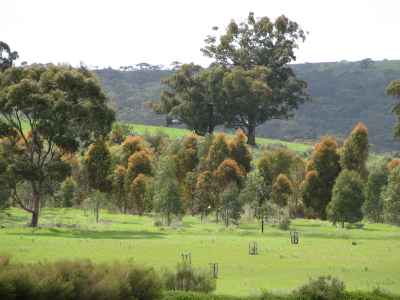














 January 2002 - This Moorpark tree was planted in winter of 2000.
It and five others nearby are doing well. Note the weld-mesh
tree guards; these are the next stage
after trees outgrow the simple, cheap, wire-netting
January 2002 - This Moorpark tree was planted in winter of 2000.
It and five others nearby are doing well. Note the weld-mesh
tree guards; these are the next stage
after trees outgrow the simple, cheap, wire-netting



























